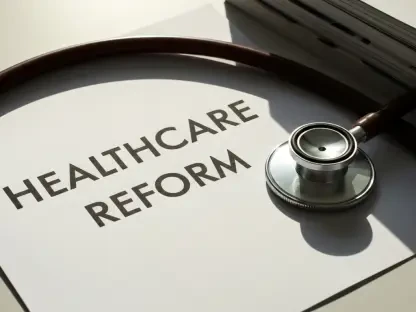Overview of the U.S. Hospital Financial Landscape
In the complex and ever-evolving healthcare industry, U.S. hospitals stand at a critical juncture, grappling with a financial landscape that reveals both progress and peril, as they navigate economic pressures and policy shifts that shape their operational realities. A comprehensive study analyzing data from 1,300 facilities across the nation paints a vivid picture of an industry experiencing improved margins while simultaneously facing mounting debt and escalating costs. This duality underscores the resilience and challenges within the sector.
The financial health of hospitals holds profound significance for the broader healthcare ecosystem, impacting stakeholders ranging from patients and providers to insurers and policymakers. Key players, including large hospital systems and smaller community facilities, must contend with external factors such as inflation, labor shortages, and changes in reimbursement structures. These elements collectively influence the ability of hospitals to deliver quality care while maintaining fiscal stability, highlighting the interconnectedness of economic trends and healthcare delivery.
As a cornerstone of community well-being, hospital finances reflect broader societal priorities and challenges. Economic downturns can strain budgets through increased uncompensated care, while policy reforms often dictate revenue streams via government programs like Medicare and Medicaid. Understanding this intricate web is essential for grasping how hospitals can sustain operations amid fluctuating conditions, setting the stage for a deeper exploration of recent financial trends and their implications.
Financial Performance: Positive Trends and Key Drivers
Rising Operating Margins and Revenue Growth
Recent data signals a promising uptick in hospital financial performance, with operating margins climbing from 1.9% in May to an encouraging 3.7% in June. This improvement points to a strategic focus on enhancing revenue per patient, rather than merely increasing patient volume. Such a shift indicates that hospitals are optimizing their service delivery to extract greater value from existing resources, a critical factor in today’s cost-conscious environment.
A significant driver behind this financial boost is the robust growth in outpatient revenue, which has emerged as a lifeline for many institutions. By prioritizing outpatient services, hospitals are capitalizing on the growing demand for less invasive, cost-effective care options that reduce overhead while meeting patient needs. This trend not only supports margin growth but also aligns with evolving consumer preferences for accessible and convenient healthcare solutions.
Strategies of High-Performing Hospitals
Hospitals that excel financially often share common traits, such as agility in balancing revenue streams with expense control. These high performers demonstrate a knack for adapting quickly to market changes, whether by investing in technology to streamline operations or by reconfiguring staff roles to enhance efficiency. Their proactive approach sets a benchmark for others striving to achieve similar stability.
Key strategies among successful hospitals include expanding outpatient offerings to capture a larger market share and diversifying services to mitigate risks tied to single revenue sources. Additionally, many adopt value-based care models that prioritize patient outcomes over volume, aligning financial incentives with quality improvements. These practices underscore the importance of innovation in navigating the fiscal challenges inherent in healthcare delivery.
Persistent Challenges Threatening Stability
Despite positive financial indicators, hospitals face formidable hurdles that could undermine recent gains. Bad debt, representing unpaid patient bills, has seen a sharper rise in June compared to prior months, possibly linked to declining enrollment in public insurance programs like Medicaid. This growing burden of uncollected revenue poses a direct threat to cash flow and long-term viability for many facilities.
Compounding this issue are escalating non-labor expenses, including the rising costs of purchased services and supplies. These expenditures strain budgets, particularly for hospitals lacking the scale to negotiate favorable contracts or absorb cost increases. The pressure to manage these expenses without compromising care quality remains a persistent concern that demands strategic oversight and resource allocation.
A stark disparity exists between high-performing hospitals and those struggling to stay afloat, with weaker institutions at heightened risk of closure or consolidation. This gap highlights systemic inequities in access to capital, expertise, and market positioning. For underperforming hospitals, the inability to address mounting debt and costs could lead to diminished community access to care, amplifying the urgency for targeted interventions.
Operational Efficiency as a Path to Resilience
Operational efficiency stands as a cornerstone for hospitals seeking to weather financial storms and maintain service delivery. Practices such as optimizing patient throughput—ensuring timely admissions and discharges—play a pivotal role in maximizing bed availability and reducing bottlenecks. Such measures directly impact revenue by enhancing capacity without necessitating costly expansions.
For smaller or struggling hospitals, tightening day-to-day operations offers a practical starting point for improvement. This includes rigorous revenue collection processes to minimize bad debt and careful monitoring of expense categories to curb unnecessary spending. While these steps require discipline, they can provide immediate fiscal relief and lay the groundwork for sustainable growth.
Strategic partnerships or affiliations also emerge as viable options for at-risk facilities needing long-term support. By aligning with larger systems or collaborative networks, smaller hospitals can gain access to shared resources, expertise, and bargaining power. These relationships not only bolster financial resilience but also ensure continued access to care for underserved communities, addressing systemic vulnerabilities.
Future Outlook for Hospital Finances
Looking ahead, the trajectory of hospital finances appears cautiously optimistic, tempered by recognition of persistent challenges that demand vigilance. Improved margins signal potential for recovery, yet the specter of rising bad debt and operational costs suggests that stability is not guaranteed. Hospitals must remain proactive in monitoring these variables to avoid erosion of recent gains.
Potential disruptors loom on the horizon, including policy changes that could alter reimbursement rates or coverage mandates, as well as economic conditions affecting patients’ ability to pay. Evolving patient needs, such as increased demand for telehealth or chronic disease management, further complicate financial planning. Navigating these uncertainties requires a forward-thinking mindset focused on adaptability and preparedness.
Continued innovation will be paramount for hospitals aiming to address systemic issues like uncollected revenue and expense inflation. Investments in technology to enhance billing accuracy, alongside efforts to diversify income sources, could fortify financial positions. As the industry evolves, a commitment to flexibility and strategic foresight will distinguish those hospitals capable of thriving amid ongoing turbulence.
Conclusion: Balancing Progress and Peril
Reflecting on the detailed analysis, it becomes evident that U.S. hospitals have achieved notable strides in financial performance, with margins showing marked improvement driven by per-patient revenue and outpatient growth. Yet, the simultaneous escalation of bad debt and non-labor expenses casts a shadow over these advancements, revealing a sector caught between progress and vulnerability. This duality captures the essence of an industry striving for balance amid complex fiscal dynamics.
Moving forward, actionable steps emerge as critical for sustaining momentum. Hospitals need to prioritize robust revenue management systems to tackle bad debt head-on, ensuring every dollar owed is pursued with precision. Embracing operational efficiencies, from streamlined patient flows to cost-effective service delivery, stands out as a non-negotiable focus for maintaining fiscal health.
Beyond immediate tactics, a broader vision for resilience takes shape, emphasizing the cultivation of strategic alliances and innovative care models. Exploring partnerships with technology firms to enhance data-driven decision-making or with community organizations to address social determinants of health offers untapped potential. These forward-looking considerations underscore that long-term stability hinges on a willingness to adapt and reimagine traditional approaches in an ever-shifting healthcare landscape.









